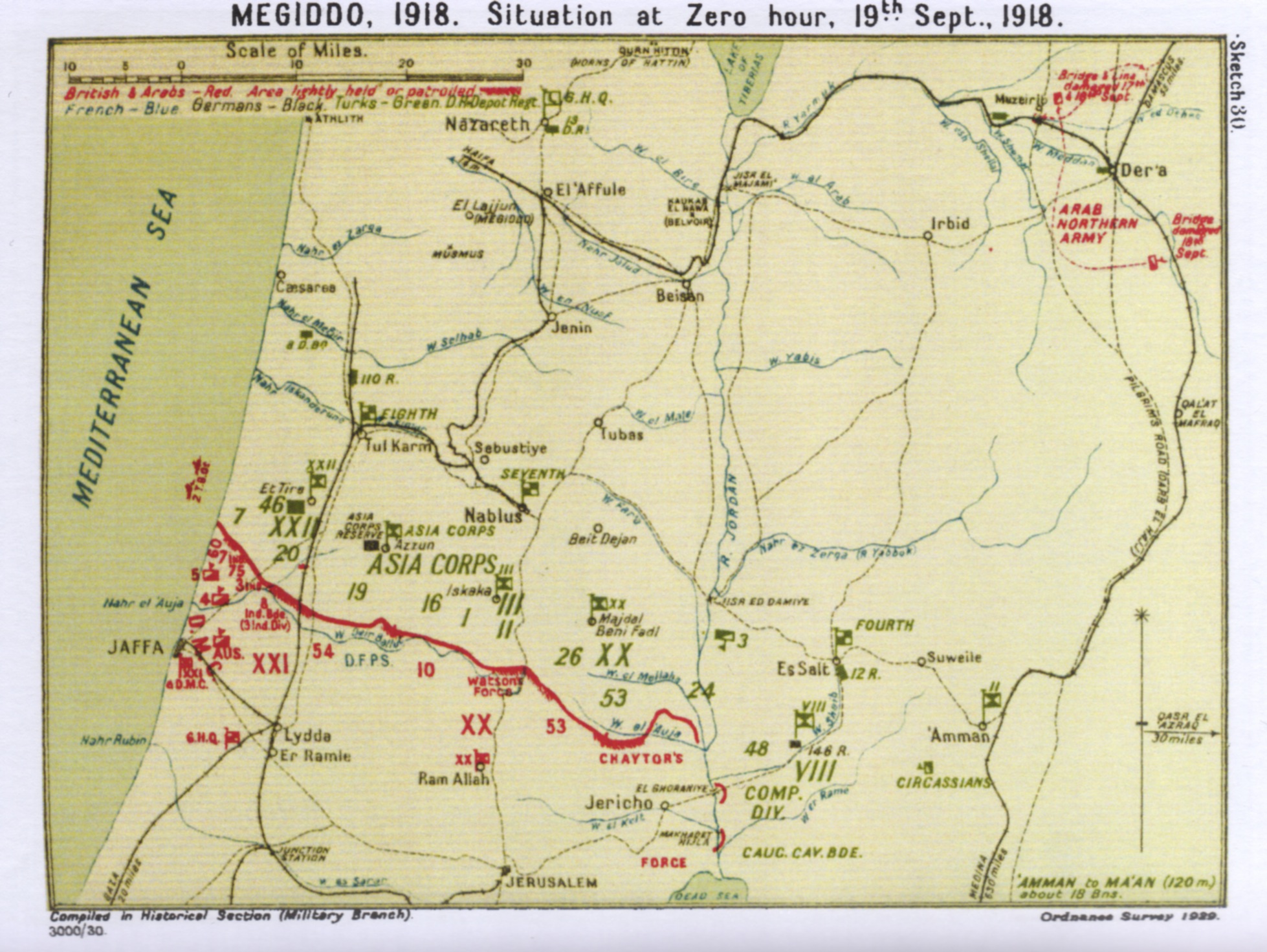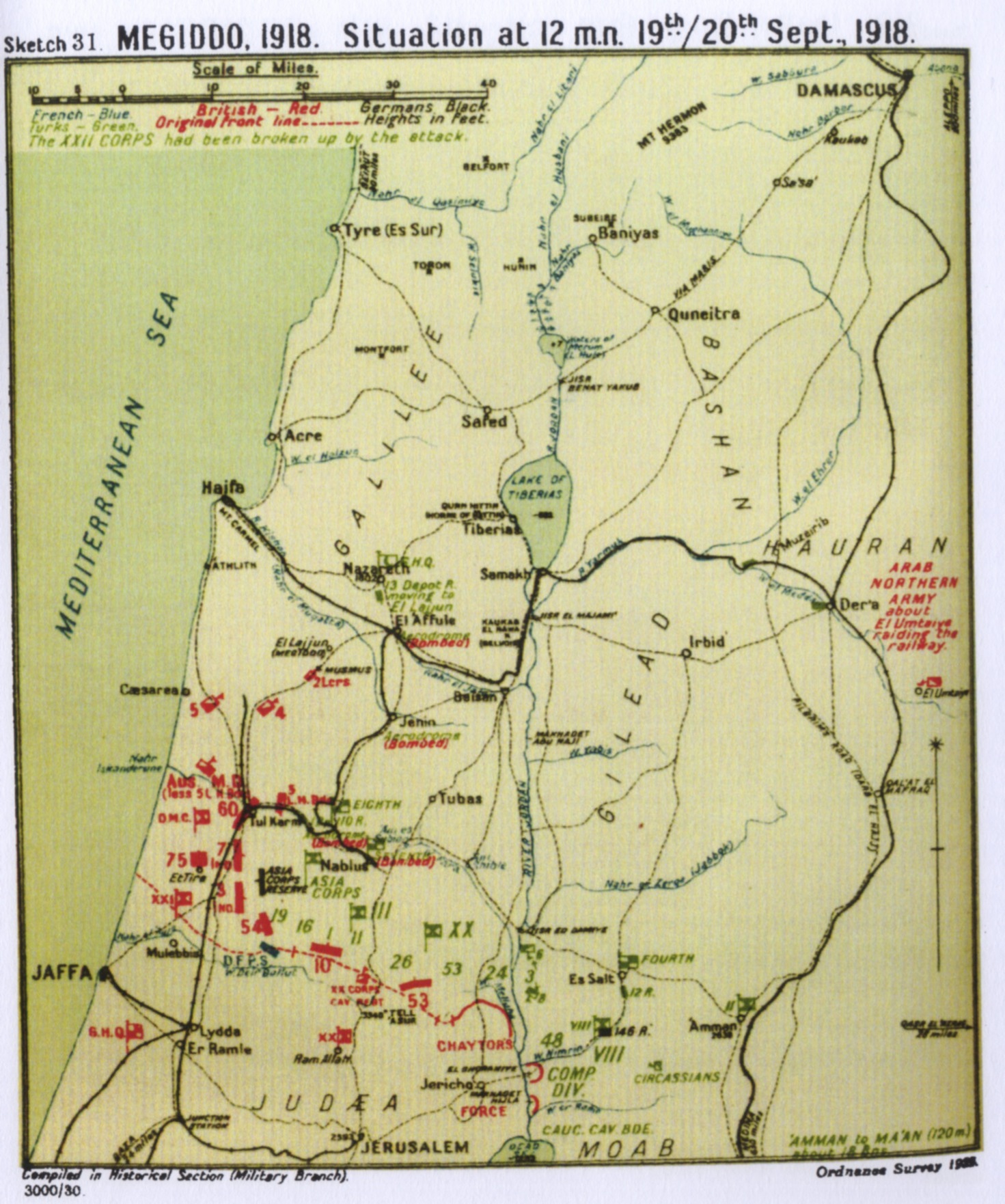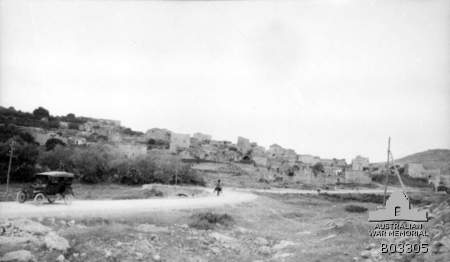|
Battle Of Megiddo (1918)
The Battle of Megiddo ( tr, ), also known in Turkish as the ("Rout of Nablus") or the ("Breakthrough at Nablus"), was fought between 19 and 25 September 1918, on the Plain of Sharon, in front of Tulkarm, Tabsor and Arara in the Judean Hills as well as on the Esdralon Plain at Nazareth, Afulah, Beisan, Jenin and Samakh. Its name, which has been described as "perhaps misleading" since very limited fighting took place near Tel Megiddo, was chosen by Allenby for its biblical and symbolic resonance. The battle was the final Allied offensive of the Sinai and Palestine Campaign of the First World War. The contending forces were the Allied Egyptian Expeditionary Force, of three corps including one of mounted troops, and the Ottoman Yildirim Army Group which numbered three armies, each the strength of barely an Allied corps. The series of battles took place in what was then the central and northern parts of Ottoman Palestine and parts of present-day Israel, Syria and Jordan. A ... [...More Info...] [...Related Items...] OR: [Wikipedia] [Google] [Baidu] |
Middle Eastern Theatre Of World War I
The Middle Eastern theatre of World War I saw action between 29 October 1914 and 30 October 1918. The combatants were, on one side, the Ottoman Empire (including the majority of Kurdish tribes, a relative majority of Arabs, and Caucasian ''Tatars''), with some assistance from the other Central Powers; and on the other side, the British (with the help of Jews, Greeks, Assyrians, some Kurdish tribes, and many Arabs, along with Hindu and Muslim colonial troops from India), the Russians (with the help of Armenians, Assyrians, and occasionally some Kurdish tribes) and the French (with its North African and West African Muslim colonial troops) from among the Allied Powers. There were five main campaigns: the Sinai and Palestine Campaign, the Mesopotamian Campaign, the Caucasus Campaign, the Persian Campaign, and the Gallipoli Campaign. There were also several minor campaigns: Arab Campaign, and South Arabia Campaign. Both sides used local asymmetrical forces in the region. ... [...More Info...] [...Related Items...] OR: [Wikipedia] [Google] [Baidu] |
Mustafa Kemal Atatürk
Mustafa Kemal Atatürk, or Mustafa Kemal Pasha until 1921, and Ghazi Mustafa Kemal from 1921 Surname Law (Turkey), until 1934 ( 1881 – 10 November 1938) was a Turkish Mareşal (Turkey), field marshal, Turkish National Movement, revolutionary statesman, author, and the founding father of the Republic of Turkey, serving as its first President of Turkey, president from 1923 until Death and state funeral of Mustafa Kemal Atatürk, his death in 1938. He undertook sweeping progressive Atatürk's reforms, reforms, which modernized Turkey into a secular, industrializing nation.Harold Courtenay Armstrong Gray Wolf, Mustafa Kemal: An Intimate Study of a Dictator. page 225 Ideologically a Secularism, secularist and Turkish nationalism, nationalist, Atatürk's Reforms, his policies and socio-political theories became known as Kemalism. Due to his military and political accomplishments, Atatürk is regarded as one of the most important political leaders of the 20th century. Ata ... [...More Info...] [...Related Items...] OR: [Wikipedia] [Google] [Baidu] |
Battle Of Samakh (1918)
The Battle of Samakh was fought on 25 September 1918, during the Battle of Sharon which together with the Battle of Nablus formed the set piece Battle of Megiddo fought from 19 to 25 September 1918, in the last months of the Sinai and Palestine Campaign of the First World War. During the cavalry phase of the Battle of Sharon the Desert Mounted Corps commanded by the Australian Lieutenant General Harry Chauvel, captured the Esdraelon Plain (also known as the Jezreel Valley and the Plain of Armageddon) behind the front line in the Judean Hills on 20 September, when the 3rd Light Horse Brigade captured Jenin. The 4th Light Horse Brigade, Australian Mounted Division was deployed guarding supply columns, and prisoners, before being ordered to attack and capture Samakh on the shore of the Sea of Gallilee. Here the Ottoman and German garrison had been ordered by the commander of the Yildirim Army Group to fight to the last man. Samakh, in the centre of a rearguard line stret ... [...More Info...] [...Related Items...] OR: [Wikipedia] [Google] [Baidu] |
Capture Of Jenin (1918)
The Capture of Jenin occurred on 20 September 1918, during the Battle of Sharon which together with the Battle of Nablus formed the set piece Battle of Megiddo fought between 19 and 25 September during the last months of the Sinai and Palestine Campaign of the First World War. During the cavalry phase of the Battle of Sharon carried out by the Desert Mounted Corps, the 3rd Light Horse Brigade, Australian Mounted Division attacked and captured the town of Jenin located on the southern edge of the Esdraelon Plain (also known as the Jezreel Valley and the plain of Armageddon) behind the front line in the Judean Hills. The Australian light horse captured about 2,000 prisoners, the main supply base and the ordnance depot of the Seventh and the Eighth Armies in and near the town. They also cut the main road from Nablus and a further 6,000 Ottoman Empire and German Empire prisoners, were subsequently captured as they attempted to retreat away from the Judean Hills. The Egypti ... [...More Info...] [...Related Items...] OR: [Wikipedia] [Google] [Baidu] |
Capture Of Afulah And Beisan
The Capture of Afula and Beisan occurred on 20 September 1918, during the Battle of Sharon which together with the Battle of Nablus (1918), Nablus, formed the set piece Battle of Megiddo (1918), Battle of Megiddo fought during the last months of the Sinai and Palestine Campaign of the First World War. During the cavalry phase of the Battle of Sharon, the 4th Cavalry Division (British Indian Army), 4th Cavalry Division of the Desert Mounted Corps attacked and captured the main communications hub at Afula, located in the centre of the Esdraelon Plain (also known as the Jezreel Valley and the plain of Armageddon), and Beisan on the plain's eastern edge near the Jordan River, some behind the front line in the Judean Hills. Infantry attacks by the British Empires XXI Corps (United Kingdom), XXI Corps had begun the Battle of Sharon on 19 September, along an almost continuous trench line from the Mediterranean across the Plain of Sharon and into the foothills of the Judean Hills. These ... [...More Info...] [...Related Items...] OR: [Wikipedia] [Google] [Baidu] |
Battle Of Nazareth (1918)
The Battle of Nazareth began on 20 September 1918, during the Battle of Sharon, which together with the Battle of Nablus formed the set piece Battle of Megiddo fought during the last months of the Sinai and Palestine Campaign of the First World War. During the cavalry phase of the Battle of Sharon the Desert Mounted Corps rode to the Esdraelon Plain (also known as the Jezreel Valley and the plain of Armageddon) behind the front line in the Judean Hills. At Nazareth on the plain, the 13th Cavalry Brigade of the 5th Cavalry Division attempted to capture the town and the headquarters of the Yildirim Army Group which was eventually captured the following day after the garrison had withdrawn. The Egyptian Expeditionary Force (EEF) attack on Nazareth was made possible by the British Empire infantry attack on 19 September which began the Battle of Sharon. The EEF infantry attacked along an almost continuous front from the Mediterranean Sea, across the Plain of Sharon and into the ... [...More Info...] [...Related Items...] OR: [Wikipedia] [Google] [Baidu] |
Jezreel Valley
The Jezreel Valley (from the he, עמק יזרעאל, translit. ''ʿĒmeq Yīzrəʿēʿl''), or Marj Ibn Amir ( ar, مرج ابن عامر), also known as the Valley of Megiddo, is a large fertile plain and inland valley in the Northern District of Israel. It is bordered to the north by the highlands of the Lower Galilee region, to the south by the Samarian highlands, to the west and northwest by the Mount Carmel range, and to the east by the Jordan Valley, with Mount Gilboa marking its southern extent. The largest settlement in the valley is the city of Afula, which lies near its center. Etymology The Jezreel Valley takes its name from the ancient city of Jezreel (known in Hebrew as Yizre'el; ; known in Arabic as Zir'ēn, ) which was located on a low hill overlooking the southern edge of the valley. The word ''Jezreel'' comes from the Hebrew, and means "God sows" or " El sows".Cheyne and Black, ''Encyclopedia Biblica'' The phrase "valley of Jezreel" was sometimes used t ... [...More Info...] [...Related Items...] OR: [Wikipedia] [Google] [Baidu] |
Judean Hills
The Judaean Mountains, or Judaean Hills ( he, הרי יהודה, translit=Harei Yehuda) or the Hebron Mountains ( ar, تلال الخليل, translit=Tilal al-Khalīl, links=, lit=Hebron Mountains), is a mountain range in Palestine and Israel where Jerusalem, Hebron and several other biblical cities are located. The mountains reach a height of . The Judean Mountains can be separated to a number of sub-regions, including the Mount Hebron ridge, the Jerusalem ridge and the Judean slopes. The Judaean Mountains formed the heartland of the Kingdom of Judah (930-586 BCE), where the earliest Jewish settlements emerged, and from which Jews are generally descended. Geography The Judaean mountains are part of a more extended range that runs in a north-south direction. The ridge consists of the Samarian Hills in its northern part, and of the Judaean mountains in its southern part, the two segments meeting at the latitude of Ramallah. The westward descent from the hard limestone country of ... [...More Info...] [...Related Items...] OR: [Wikipedia] [Google] [Baidu] |
Battle Of Arara
The Battle of Arara took place on 19 September 1918 during the Battle of Sharon, which along with the Battle of Nablus formed the set piece Battle of Megiddo fought between 19 and 25 September in the last months of the Sinai and Palestine Campaign of the First World War. During the infantry phase of the Battle of Sharon the British Empire 60th Division, XXI Corps attacked and captured the section of the front line nearest the Mediterranean coast under cover of an intense artillery barrage including a creeping barrage and naval gunfire while the 3rd (Lahore), 7th (Meerut) and 75th Divisions XXI Corps attacked the Tabsor group of trenches. These Egyptian Expeditionary Force (EEF) victories over the entrenched Ottoman Eighth Army, composed of German and Ottoman soldiers, began the Final Offensive, ultimately resulting in the destruction of the equivalent of one Ottoman army, the retreat of what remained of two others, and the capture of many thousands of prisoners and man ... [...More Info...] [...Related Items...] OR: [Wikipedia] [Google] [Baidu] |
Battle Of Tabsor (1918)
The Battle of Tabsor was fought on 19–20 September 1918 beginning the Battle of Sharon, which along with the Battle of Nablus formed the set piece Battle of Megiddo fought between 19 and 25 September in the last months of the Sinai and Palestine Campaign of the First World War. During the infantry phase of the Battle of Sharon the British Empire 60th Division, XXI Corps attacked and captured the section of the front line nearest the Mediterranean coast under cover of an intense artillery barrage including a creeping barrage and naval gunfire. This Egyptian Expeditionary Force (EEF) victory over the entrenched Ottoman Eighth Army, composed of German and Ottoman soldiers, began the Final Offensive, ultimately resulting in the destruction of the equivalent of one Ottoman army, the retreat of what remained of two others, and the capture of many thousands of prisoners and many miles of territory from the Judean Hills to the border of modern-day Turkey. After the end of the ba ... [...More Info...] [...Related Items...] OR: [Wikipedia] [Google] [Baidu] |
Battle Of Tulkarm (1918)
The Battle of Tulkarm took place on 19 September 1918, beginning of the Battle of Sharon, which along with the Battle of Nablus (1918), Battle of Nablus formed the set piece Battle of Megiddo (1918), Battle of Megiddo fought between 19 and 25 September in the last months of the Sinai and Palestine Campaign of the First World War. During the infantry phase of the Battle of Sharon the British Empire 60th (2/2nd London) Division, 60th Division, XXI Corps (United Kingdom), XXI Corps attacked and captured the section of the front line nearest the Mediterranean coast under cover of an intense artillery barrage including a creeping barrage and naval gunfire. This Egyptian Expeditionary Force (EEF) victory over the entrenched Eighth Army (Ottoman Empire), Ottoman Eighth Army, composed of German Empire, German and Ottoman Empire, Ottoman soldiers, began the Final Offensive, ultimately resulting in the destruction of the equivalent of one Military of the Ottoman Empire, Ottoman army, the re ... [...More Info...] [...Related Items...] OR: [Wikipedia] [Google] [Baidu] |
Plain Of Sharon
The Sharon plain ( ''HaSharon Arabic: سهل شارون Sahel Sharon'') is the central section of the Israeli coastal plain. The plain lies between the Mediterranean Sea to the west and the Samarian Hills, to the east. It stretches from Nahal Taninim, a stream marking the southern end of Mount Carmel in the north, to the Yarkon River in the south, at the northern limit of Tel Aviv, over a total of about . The level of the Sharon plain is connected to the level of the Mediterranean Sea by the Sharon Escarpment. Parts of the Plain are included in the Central, Haifa and Tel Aviv Districts of Israel. History Early The Sharon valley is mentioned in an ancient Egyptian stele of Amenhotep II, and as the Sharon field containing both Jaffa and Dor on the Eshmunazar II sarcophagus. The Plain of Sharon is mentioned in the Bible (1 Chronicles 5:16, 27:29; Book of Isaiah 33:9, 35:2, 65:10), including the famous reference to the enigmatic "Rose of Sharon" ( Song of Songs 2:1). Ex ... [...More Info...] [...Related Items...] OR: [Wikipedia] [Google] [Baidu] |









